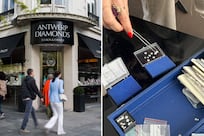Sometimes an argument feels just too convenient to be true. "All the times in our lives we've spent feeding at the trough of television, movies, the internet, and other assorted screens, consuming super-size amounts of visual media," Stephen Apkon tells us in his digital-age manifesto The Age of the Image, "all that time was not wasted, not one minute of it."
We live, Apkon tells us, in a time where the written word has been superseded by the moving image, the now preeminent means of instantaneous and powerful communication.
Apkon argues forcefully for digital literacy as a precondition of 21st-century education. We must possess a degree of sophistication in reading them: "As viewers of these images, we still have many questions to ask. What happened before or after the camera was recording, and how might that footage change the story? What is outside the frame that might help tell a different story? Who is shooting the footage, and who is distributing it, and what agendas might they have?"
Apkon seeks to train a world of watchers to ask the necessary questions about the provenance of the truths flashing back on their screens. But in the same way that no one would confuse Shakespeare with a fashion magazine, some images must be superior to others, and some must be nothing other than empty digital calories.
The irony, of course, is that Apkon's polemic does not itself take the form of a YouTube video, but appears between hard covers. "If you wrote a book or a speech it takes a long time to get it out," Apkon quotes a fellow educator. "There's a whole other level to it when you add images." Writing may take longer, but as Apkon clearly knows, when crafting an argument, sometimes only the written word will do.
Elizabeth Diller and Ricardo Scofidio probably did not need to skim through Apkon's book to familiarise themselves with the primacy of the moving image, or its increasingly vital role in 21st-century culture.
Architects by training, now famous for their work on revamping New York's Lincoln Center arts complex and the High Line elevated park, Diller and Scofidio actually began as architectural provocateurs crash-landed in the art world.
Edward Dimendberg's Diller Scofidio + Renfro is a record of the early years of their partnership, when, according to architecture critic Herbert Muschamp, they were "gobbled up by the art world with scarcely a burp". It is not, primarily, a book about their architecture, and as such may be something of a disappointment for those looking to learn more about their better-known work. Instead, it is mostly concerned with Diller and Scofidio's elaborately designed performance-art japes, such as the 2,500 traffic pylons laid out in a busy Manhattan square, drawing on their architectural knowledge to playfully tweak the excesses of the art world.
Diller + Scofidio (Renfro joined the partnership later on) were running what they playfully referred to as the Department of Money Losing Projects. Emerging at the height of postmodernism's joyless ascendance, they projected a different image, of "the designer as cultural commentator with a hunger for ideas". Quotation and self-referentiality were not passionless academic exercises, but serious attempts to wrestle with the nature of the moving image.
Their conclusions were not always ones to warm the heart of the likes of Apkon. "Indigestion," a collaborator says of one of their installations, "deals with the false promise of interactivity. The audience has the illusion of narrative power - they seem to be able to control the direction of the story, by making meaningful choices - and yet each narrative proves ultimately unyielding, subject only to the will of the author."
Eventually, their architectural work would take on the form of their installation work, drawing on the same pool of Fluxus-style straight-faced mockery. A public-housing tower in Japan is redesigned by the careful application of a series of instructions Dimendberg compares to a musician's performance score. And in tackling the Lincoln Center project, their biggest ever, Diller + Scofidio made use of the filmmaking skills they had honed as art-world pranksters to sell its stakeholders on their vision. Whatever the format, whatever the scope of their work, Diller Scofidio + Renfro have continually circled back to the same question: "In what language could architecture speak? In whose voice?"
Diller Scofidio + Renfro were provocateurs posing as architects, and the three artists profiled in Cary Levine's group biography Pay for Your Pleasures were similarly playing off the familiar codes of an insular scene to unsettle their audiences. They were, as Levine says of the graphic artist Raymond Pettibon, "offering irony, insincerity, contradiction, and ambiguity, essentially driving a wedge between form and content".
Music gave Pettibon, Mike Kelley and Paul McCarthy a calling, a community, and a doctrine to undermine. Kelley had been in a band before punk's arrival, and what he saw as its unstinting orthodoxy drove him to the freer turf of art. Pettibon, whose brother is Black Flag guitarist Greg Ginn, was nurtured by the Southern California punk-rock scene, the excesses and hypocrisies of which he proceeded to thoroughly mock.
Punk was masculine, violent, and lacking in frills; their work was feminine, jeering and devoted to a devious simplicity that paid tribute to and mocked all systems of belief. Their art - Pettibon's drawings of punk scenesters, McCarthy's performance-art provocations, Kelley's odes to nonsense - were "composed of conflicting codes and signals, smashed together in ways that magnify their incoherence".
These works were meant to unsettle their too-comfortable audience, to make them angry or rattle them. McCarthy's Hot Dog had him stuffing his face with hot dogs, then taping his mouth shut and struggling to avoid vomiting. The audience watches and wrestles with the knowledge that their own natural response - to vomit - might spell the artist's choking on his own vomit and possibly dying.
The moving image may be ascendant, but not everyone has boarded the bullet train to the 21st century. Some Neanderthals persist in preferring the written word as a means of communication. Eschewing Skype, video chat, or perky YouTube videos, the 70-something writers Joseph Epstein and Frederic Raphael engage in a year-long email exchange in Distant Intimacy. Epstein and Raphael agree to correspond despite never having met in the flesh, and the slow creep of intimacy into their letters gives Distant Intimacy the feel of a bromance for the pensioner set. "There is, I mean," Raphael tells Epstein, "something funny and slightly magic about what feels like a close friendship of our kind."
Epstein and Raphael get to know each other while trading jibes about literary editors and ribald stories about writers and academics and actresses past. Saul Bellow is "touchy, unkind, nasty, and blackhearted"; about Isaiah Berlin, Raphael notes that "had he been a washbasin, Isaiah would have had only one tap and it would've been tepid".
About another academic, Epstein remarks that "he was all microscope, and wrote as if the telescope, not to speak of ordinary eyesight, had not yet been invented". The epistolary form (or e-pistolary, as Epstein and Raphael would have it) is a rich and unexplored one, and the two authors can be biting and witty, but in their relentless, often gratuitous nastiness, like two gossips trading barbs about their betters, they stifle much of the natural warmth of the exchange of letters.
George Steiner, Gore Vidal and Susan Sontag come in for merciless drubbings. Shirley Jackson is dubbed "a fat writer", as if nothing more need be said about the author of The Lottery.
Epstein, an acclaimed essayist and short-story writer, and Raphael, a screenwriter and novelist, bond over their shared interest in combating anti-Semitism. Calling out prejudice is a noble task, which only makes it all the more surprising how distractingly large a portion of Distant Intimacy is devoted to cattily discussing the sexual orientations of various writers and performers of their acquaintance.
The gurus of the wireless streaming cloud utopia would do well to be reminded that once upon a time, the printed word was the internet: speedy, democratic, provocative, revolutionary. Philip F Gura, who has written previously about American Transcendentalism, returns to the 19th century with Truth's Ragged Edge: The Rise of the American Novel. Documenting the period extending roughly from James Fenimore Cooper to Herman Melville, Gura depicts a literary culture still indebted to its British elders, and struggling with "the contest between civic duty and individualism". In wrestling with the warring ideals of the community and the individual, the early 19th-century American novel was also drawn to the nation's outcasts, those left behind by its promise of equality: Native Americans, African Americans and women.
And novels could rock the world: Harriet Beecher Stowe's Uncle Tom's Cabin was inspired by Stowe's sister Isabella, who told her that "if I could use a pen as you can, I would write something that would make this whole nation feel what an accursed thing slavery is". Uncle Tom's Cabin went on to sell 10,000 copies in its first week, 100,000 in its first two months, and 300,000 in its first year. There were Uncle Tom's Cabin ceramics, sheet-music covers, and visiting cards, and eventually a stage show as well.
There was also a Civil War inspired, in some fashion, by the success of the novel. Abraham Lincoln credited Stowe as "the little woman who wrote the book that started this great war".
Leaning as it does on extended plot description and biography, Truth's Ragged Edge is decidedly dry, but its depiction of a little-explored era in American letters is eye-opening.
Saul Austerlitz is the author of Another Fine Mess: A History of American Film Comedy.





